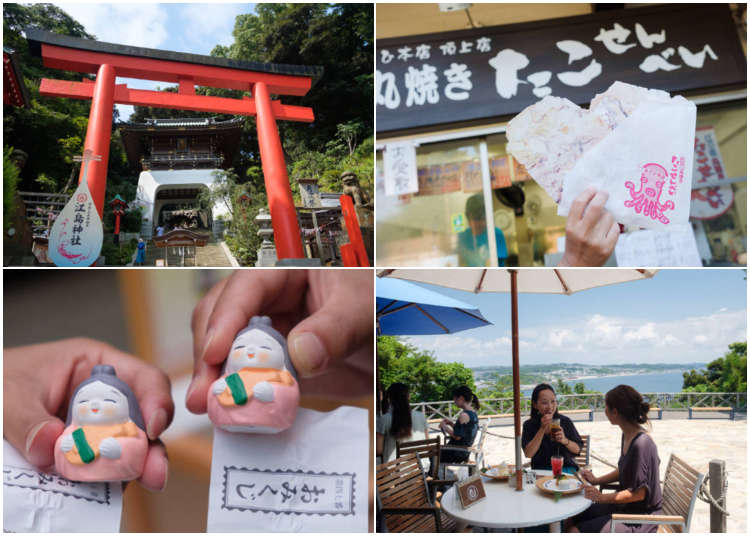
The Shonan and Enoshima area is one of the most popular day-trip destinations for both Tokyo locals and tourists. Even though the beautiful island is easily accessible from the capital, a lot of people only visit the nearby Kamakura with its many shrines and temples. That’s a shame because Enoshima is a treasure trove of amazing spots and discoveries! Come with us on a tour along its must-visit spots!
Enoshima, a Stunning Island Only One Hour Away from Tokyo
Enoshima is in the Shonan area and offers unique sights and experiences throughout the year, fun for families, couples, friends, and solo travelers alike! From shrines and temples to gourmet delights and bathing in the sea, there’s much to see and do.
It takes about one hour from Tokyo to Katase Enoshima Station on the Odakyu Line. After meeting friends at the station, we head straight for Enoshima!
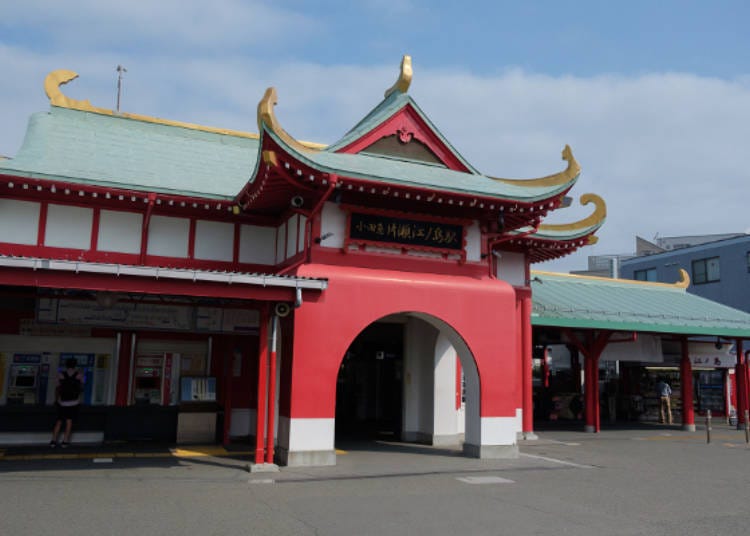
After about 5 minutes of walk, we reach the two bridges that lead to Enoshima. One of them is the “Enoshima Ohashi” for cars only, the other one is a pedestrian bridge called “Enoshima Bentenbashi.”
In the distance, we can see the lighthouse “Sea Candle” rising to the blue sky, getting us excited for our trip. A pleasant sea breeze and the aroma of the ocean accompanies our leisurely walk across the bridge.
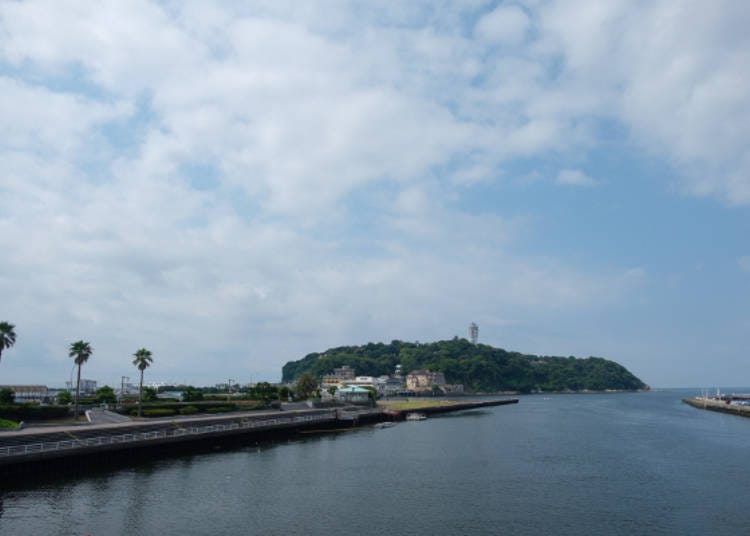
Crossing the bridge takes about five minutes and you’re already on Enoshima! The Enoshima Benzaiten Nakamise Street stretches right in front of us. It’s the approach to Enoshima Shrine and is dotted with shops and eateries.
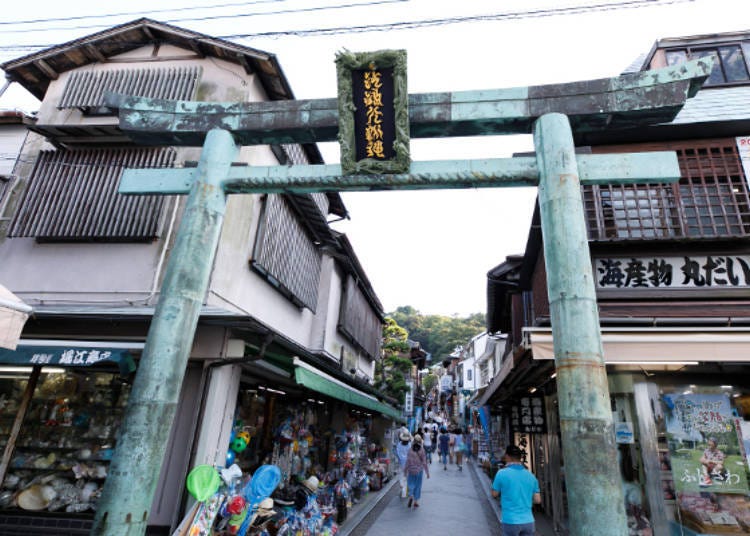
The shops on this street open at around 10:00 to 11:00 a.m. We arrived early at about 9:00 p.m., so we just leisurely strolled through the quiet area, taking in the scenery. That’s a clear benefit of getting up early!
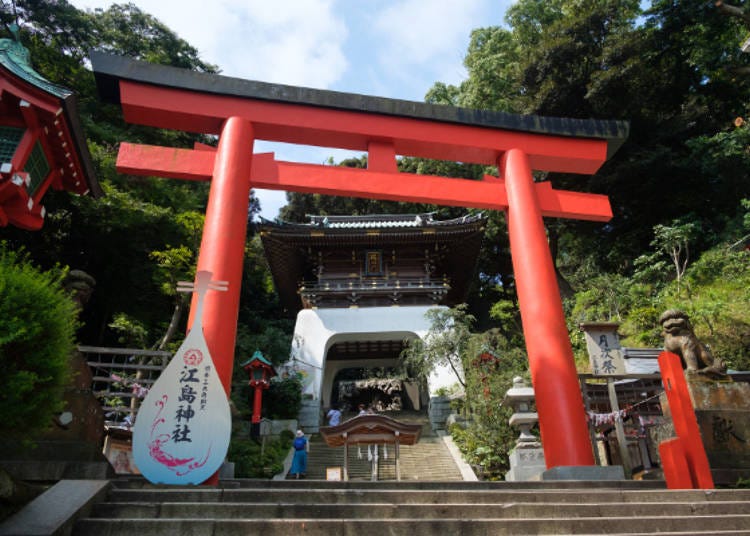
Just behind the shopping street rises a large vermilion torii gate, and next to it on the left is the “Enoshima Escalator.” As its name suggests, it takes you up to the summit without having to walk. The entire escalator is divided into three sections and made up of four escalators in total. Walking to the top takes about 20 minutes while an escalator ride is over in four minutes.
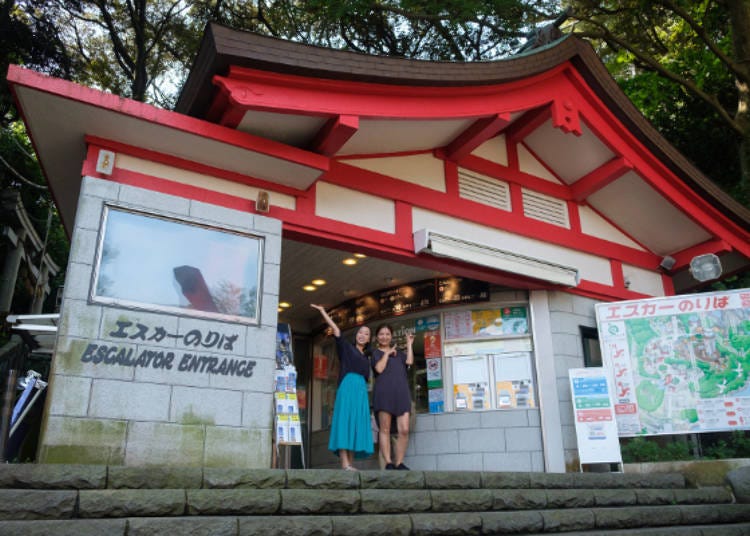
Enoshima is dotted with stairs and slopes, so the escalator is a good choice for people who aren’t too confident in their hiking skills. We decided to take the escalator as well.
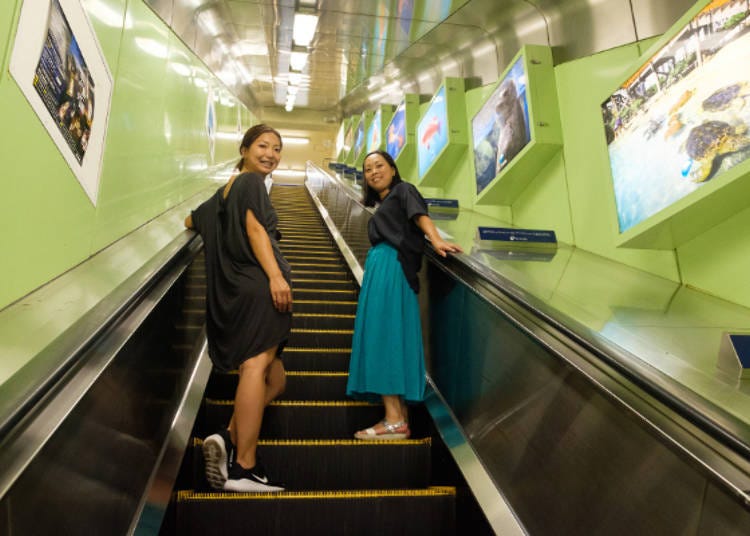
-
Enoshima Escalator江の島エスカー
- Address 2-3-9 Enoshima, Fujisawa-shi, Kanagawa-ken 251-0036
Hours: 9:00 a.m. – 7:05 p.m.
Closed: open every day
Fee: 360 yen for adults, 180 yen for children / only the first section: 200 yen for adults, 100 yen for children / section 2 and 3: 180 yen for adults, 90 yen for children / only the third section: 100 yen for adults, 50 yen for children
*Adults are junior high students and older, children are elementary students, free for children younger than elementary school age
Enoshima Shrine: Discover the Ancient Legend of Benzaiten and the Dragon
After our elevator rides, we arrive at Enoshima Shrine. On the right is a pond with a white dragon and a basin used to cleanse your hands for the shrine visit. Enoshima Shrine is deeply linked to Gozuryu, a five-headed dragon.
The legend goes that this dragon plagued the villagers of nearby Kamakura, but ended up falling in love with the Buddhist deity Benzaiten. She was able to reason with the dragon, causing him to see the error of his way and repent by becoming the protector of the area, transforming into a hill on Enoshima itself. Benzaiten is enshrined at Enoshima Shrine, now known to bestow good fortune for marriage and matchmaking.
The five-headed dragon, on the other hand, is enshrined in Ryukomyo Shrine in Kamakura, and it is said that if you visit both of these shrines, you’ll find your destined significant other.

After purifying our money, we want to find out why Enoshima Shrine is split up in different parts and why there are so many dragons. For that, we talk to Mr. Muroi of Enoshima Shrine.

“Originally, Enoshima Shrine was located inside Enoshima Iwaya Cave, but that cave cannot be accessed when the sea is rough. That is why it was divided into three places on Enoshima: Hetsumiya, Nakatsunomiya, and Okutsunomiya. This here is Hetsunomiya, where three sister deities are enshrined. It is also one of the Kamakura Enoshima Shichifukujin (Seven Lucky Deities) because Benzaiten is enshrined in Kamakura’s Tsurugaoka Hachimangu Shrine and in two places on Enoshima,” he says.
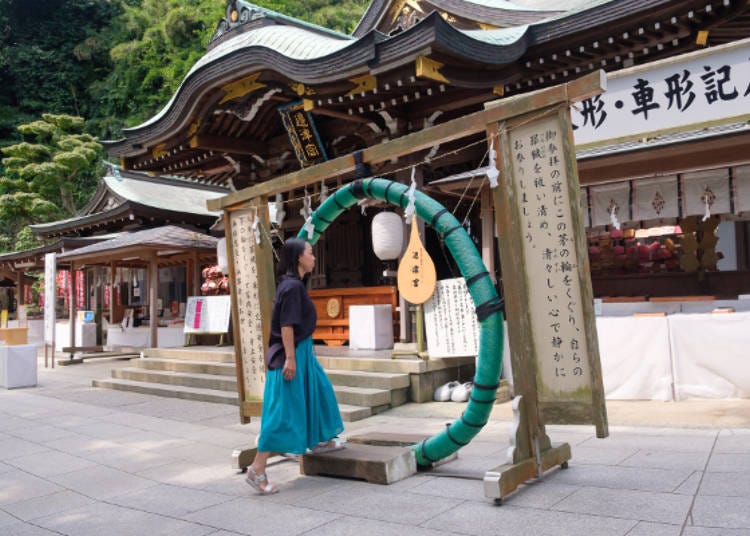
A grass ring is set up in front of the shrine’s main hall year-round and Mr. Muroi tells us how to do it right. We pass through and go left, right, then left again, drawing an 8 with our steps. He also says that the formal way of worshiping at the shrine is approaching it after you’ve finished the final ring passing.
While everyone is free to visit the shrine as they please, it was fun to learn the meaning and formal way of worship from an expert.
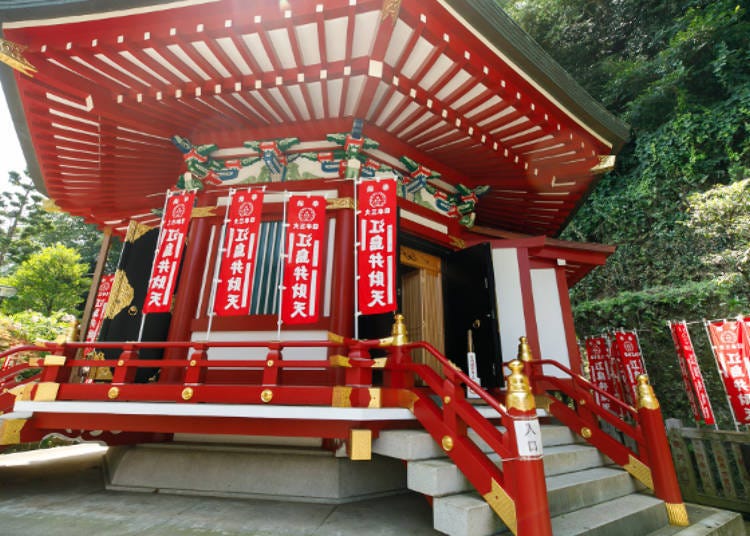
You’ll also find the “Hoanden” Hall at the side of Hetsumiya (admission is 200 yen foe adults, 50 yen for elementary school students, and free for children younger than that). Here is where the protector Happi Benzaiten and the deity of music Myo’on Benzaiten statues can be found. They’re important cultural properties of Kamakura. This is one of the Three Great Shrines of Benzaiten in Japan.
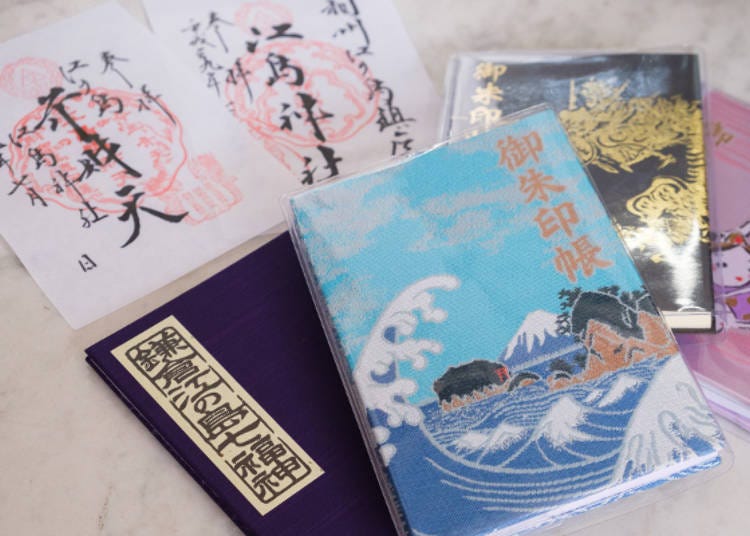
There’s a custom of collecting stamps at each temple and shrine you visited in Japan. This shrine has two; one of Enoshima Shrine and one of Benzaiten. Getting both of them seems to be the most popular option. If you don’t have a stamp book yet, you can get one here—especially sought-after are the blue ones with Enoshima and Mount Fuji.
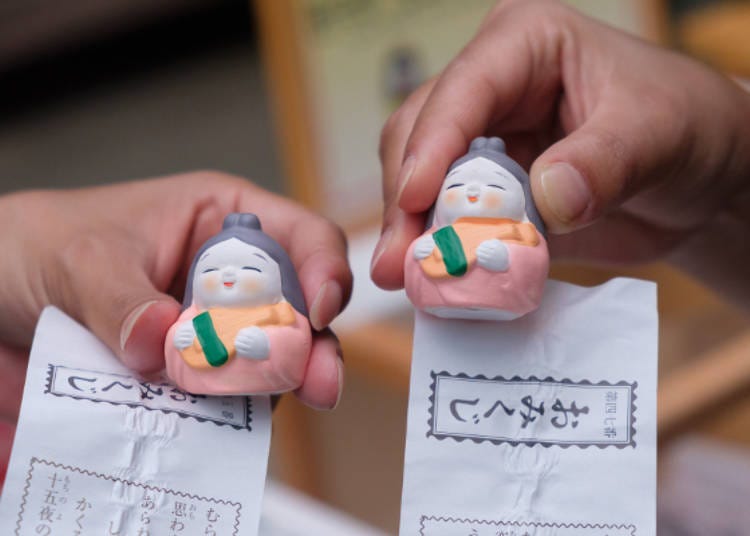
Further ahead is the musubi no ki, a tree said to bring good fortune because the two trunks share a single stem. You can get wishing plaques (500 yen), write your wish on it, and hang it on the tree to leave your destiny to the deities.
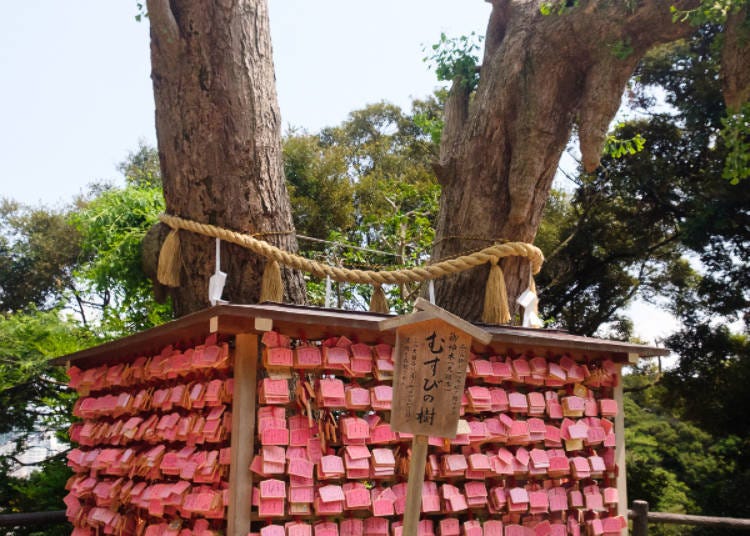
We left Hetsumiya behind us and headed for the next escalator. It takes us up to the Nakatsunomiya Shrine. It’s a vivid vermilion building that has a slightly different atmosphere than the one we just visited. The second of the three sisters is enshrined here.
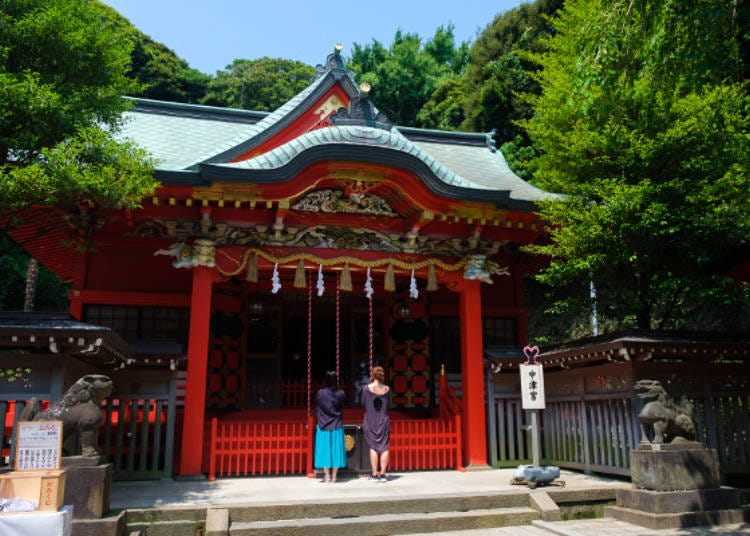
Let’s worship first, asking for good fortune and protection from disasters.
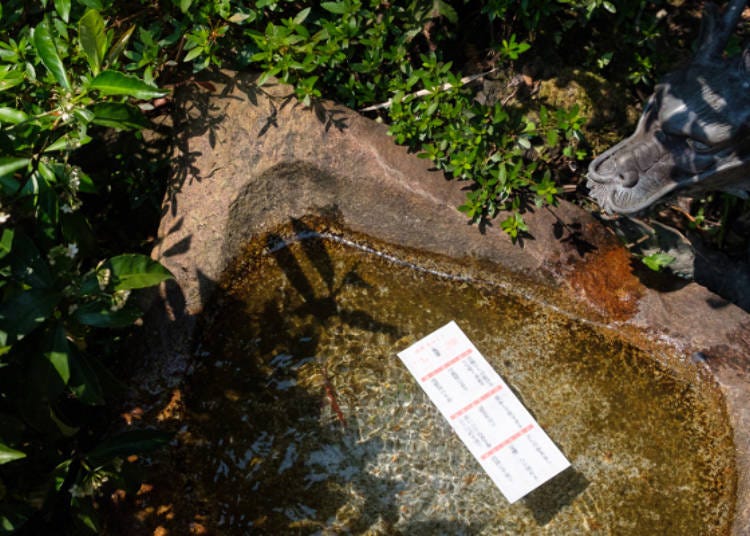
Here, people can get mizu mikuji, fortune slips (100 yen) that unfold in the water. We out ours in the garden ornament called suikinkutsu just behind Nakatsunomiya Shrine. It takes about 10 seconds until the characters appear...
...and we got Great Fortune!
Having worshiped, we move on and suddenly the ocean appears behind the trees! It’s a stunning sight and we pause a minute to take it in.
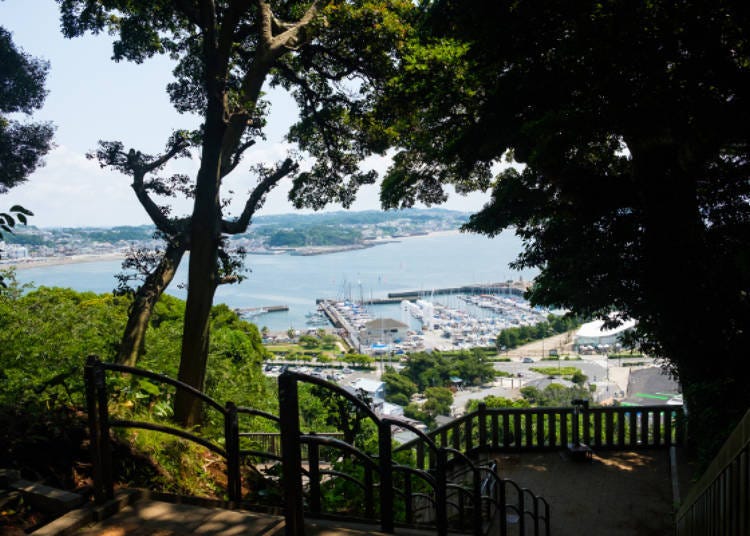
The 360-Degree View from the Sea Candle: See as Far as Mount Fuji
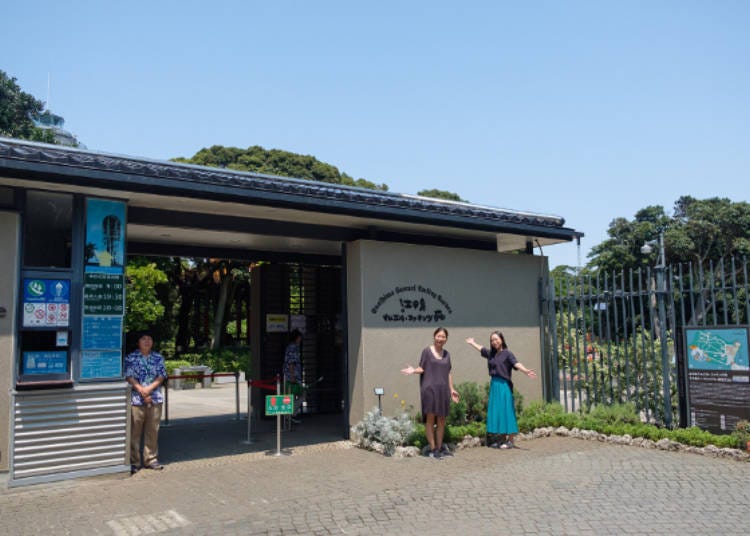
We’re taking the third escalator and go up to the Samuel Cocking Garden. It is filled with rare plants and a stunning botanical garden that sprawls at the foot of the Sea Candle lighthouse. We pay the admission fee of 200 yen and head right in.
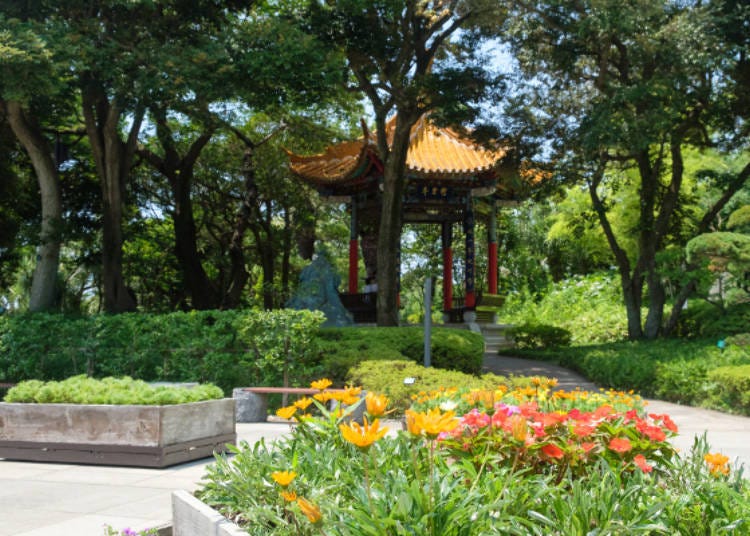
Camellias are in season from February to March, roses blossom in spring, summer, and autumn, the common hibiscus can be seen in summer, and hydrangeas are most beautiful during the rainy season. The garden is also home to plenty of rare flowers such as the sentry plant that only blossoms once every other decade. With blossoming flowers around the year and illuminations during winter, the Samuel Cocking Garden is always worth a visit.
We slowly stroll towards the Sea Candle while admiring the many different plants of the garden (admission is 300 yen for adults, 150 yen for elementary school students).
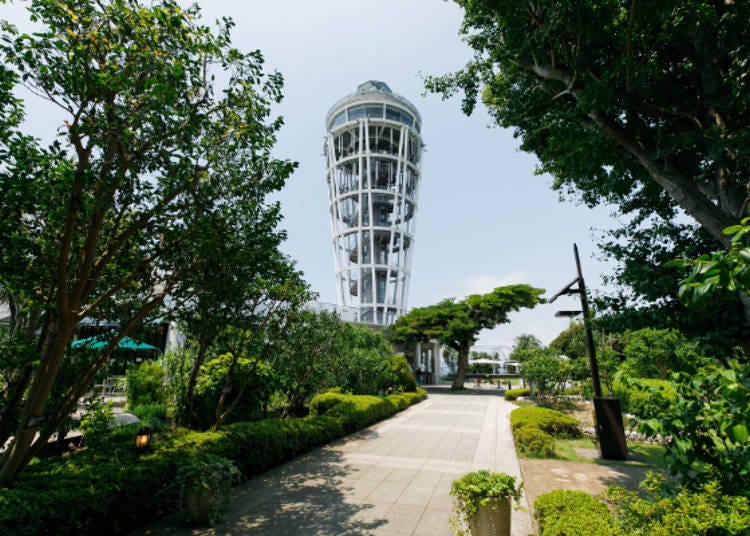
Enoshima’s “Sea Candle” lighthouse is a prominent sybol of the Shonan area. Its observation platform offers a magnificent 360-degree view, boasting sights such as Mount Fuji, Tokyo Tower, the Boso Peninsula, Izu Oshima, and more. An elevator takes you to the observation deck from the first floor. Leisurely stroll around the panorama windows and peek through the coin-type binoculars.
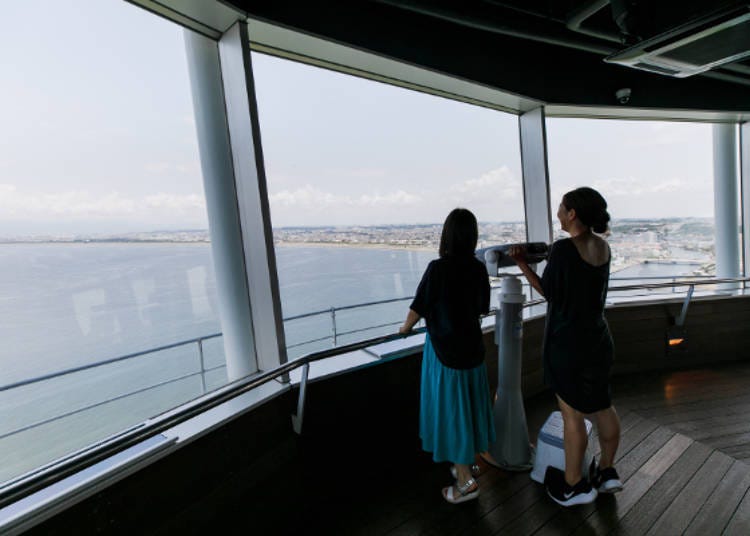
After enjoying the view from the indoor part of the observation deck, we ventured outside. Enoshima’s lush greenery creates a stunning harmony with the blue sky, a sight that seems to refresh you to the very core. Enjoy the sea breeze, too!
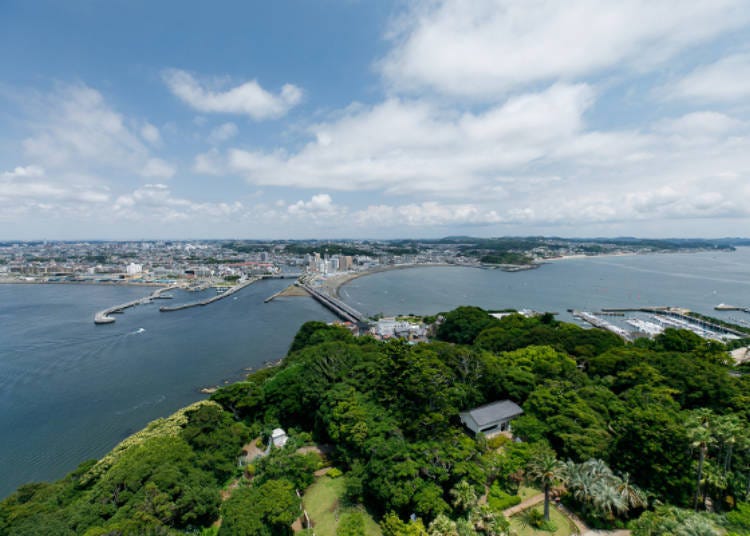
If you plan on using the escalators and also want to see Samuel Cocking Garden and the Sea Candle, we recommend the set ticket (750 yen for adults, 370 yen for elementary school students). There is also a ticket called the “eno-pass,” which includes admission to the Enoshima Iwaya Cave on top of everything else (1,000 yen for adults, 500 yen for children). With these set tickets, you can come and go however many times you want in one day, so if you plan on spending an entire day on Enoshima, they’re a great option.
-

-
Address
Enoshima 2-3-28, Fujisawa-shi, Kanagawa, 251-0036
View Map -
Nearest Station
Katase-Enoshima Station (Odakyu Enoshima Line)
20 minutes on foot
- Phone Number 0466-23-0623
-
Address
Enoshima 2-3-28, Fujisawa-shi, Kanagawa, 251-0036
-

-
Address
Enoshima 2-3, Fujisawa-shi, Kanagawa, 251-0036
View Map -
Nearest Station
Enoshima Station (Enoshima Electric Railway Line)
25 minutes on foot
- Phone Number 0466-23-2444
-
Address
Enoshima 2-3, Fujisawa-shi, Kanagawa, 251-0036
Hawaii on Enoshima: Enjoy Heavenly French Toast at LONCAFE
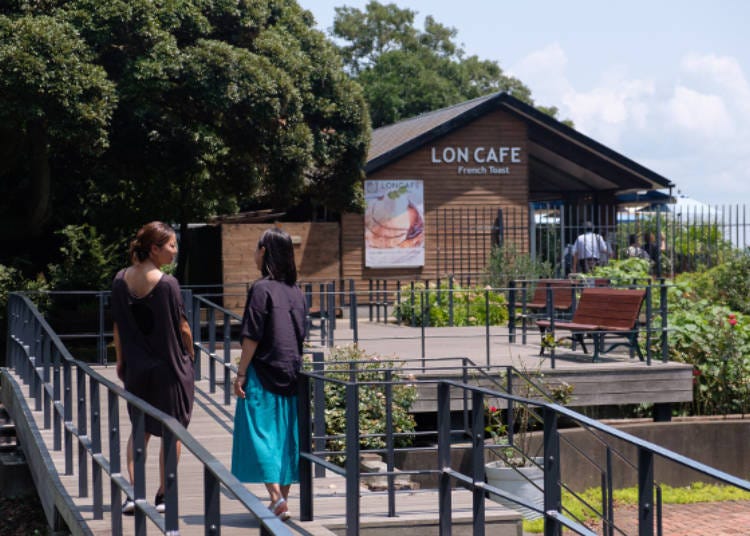
We needed a short break after exploring the garden and Sea Candle, so we headed to LONCAFE inside Samuel Cocking Garden. Ever since the French toast specialty café opened in 2003, it has enjoyed constant popularity, often boasting long queues of people who want to try the famed French toast. It sees about 300 guests on average on Saturdays and Sundays, but even during the weekend, LONCAFE is never empty.
The café’s French toast charms people with incredible crispiness on the outside and wonderful fluffiness on the inside. Each French toast is made carefully to the point of perfection!
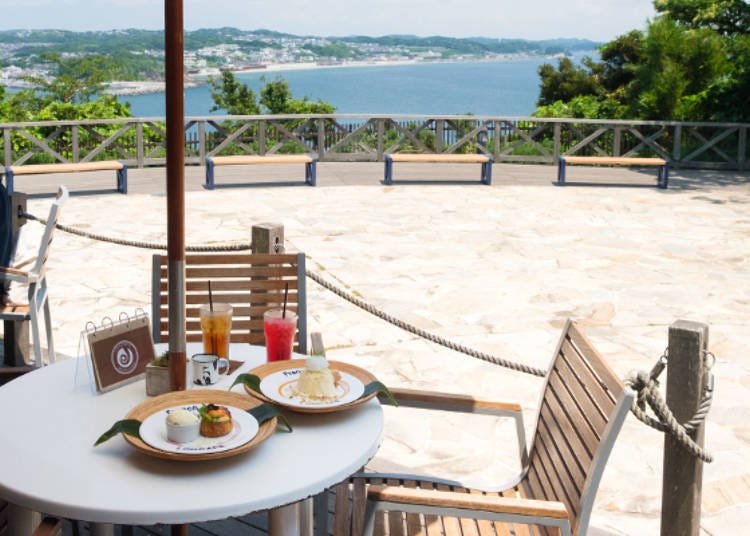
We sat down on the terrace and immediately ordered the popular “Rich Crème Brûlée Set” (1,490 yen) which features crème brûlée on the iconic French toast, as well as the “Caramel Banana Walnut Set” (1,188 yen) with plenty of ice cream. These French toast sets also include soft drinks each, and the café’s drink menu changes daily.
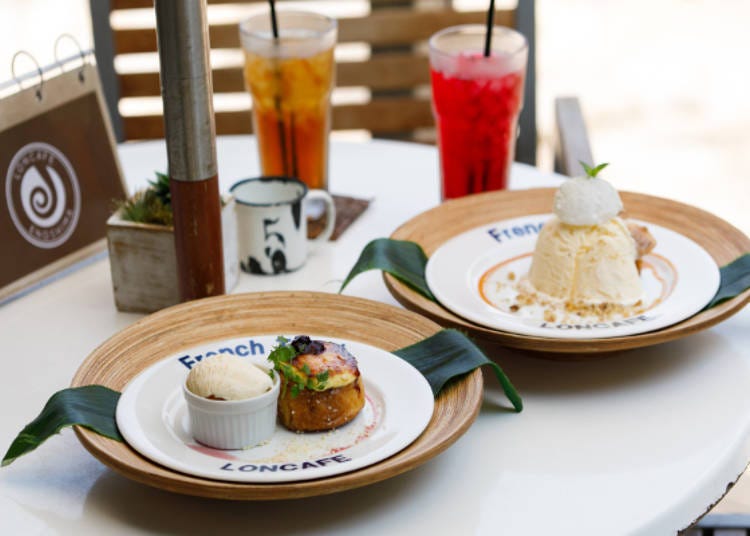
From the first bite on, we promise that you’ll be entirely enthralled by the melty goodness spreading in your mouth! The rich crème brûlée matches the French toast extremely well, complementing the sweetness of the dish with gently bitter caramel. It’s no surprise that this is the most popular option on the menu. It’s certainly a recommendation for people who don’t like their desserts too sweet. The caramel banana walnut combination is also excellent, harmonizing well with the vanilla ice cream on top.
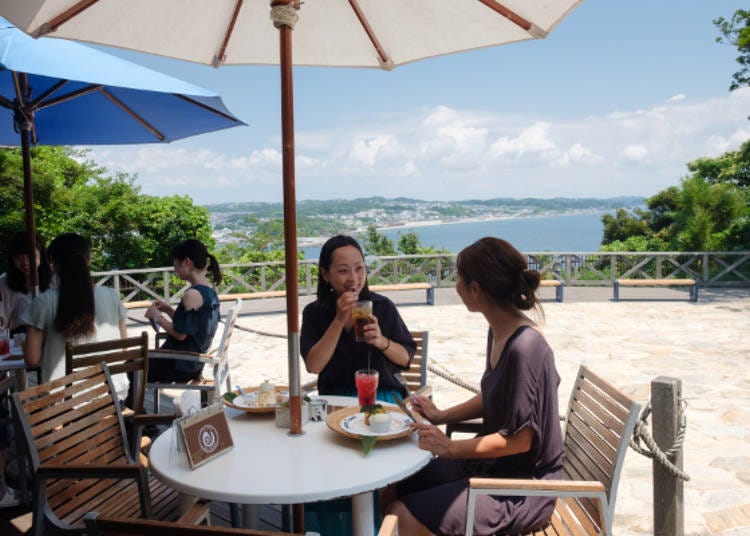
The café is most crowded between noon and 3:00 p.m., regardless of whether you visit during the week or on the weekend. It’s best to stop by for a relaxed afternoon snack or a delicious brunch. You’ll have a great view of the ocean from any seat, both inside and on the terrace. It’s particularly nice to sit outside during spring and autumn when the sea breeze is gentle and the weather fair. Winter is also great, as LONCAFE sets up heaters outside and changes its table seats inside to wonderfully warm kotatsu seats.
-
LONCAFELONCAFE 江ノ島本店
- Address Inside Samuel Cocking Garden, 2-3-38 Enoshima, Fujisawa-shi, Kanagawa-ken 251-0036
- Phone Number 0466-28-3636
Hours: 11:00 a.m. – 8:00 p.m. (last order at 7:30 p.m.), open from 10:00 a.m. on Saturdays
Closed: irregularly
*A separate admission fee is necessary to enter the Samuel Cocking Garden (200 yen for adults, 100 yen for children)
Enoshima Iwaya Cave: The Mystical Cave of the Dragon Legend
After enjoying our French toasts, we left the Samuel Cocking Garden and proceeded to explore Enoshima, encountered by several slopes and stairs!
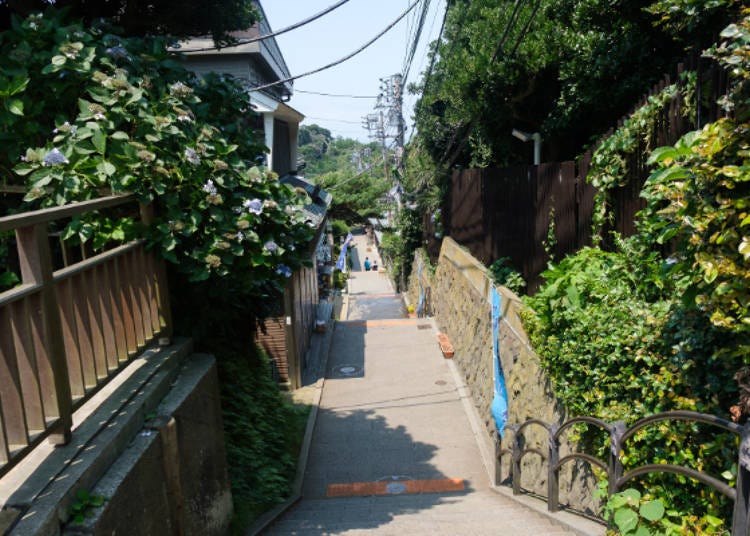
As you’re on O-Iwayamichi street heading towards Okutsunomiya, turn right. You’ll see Mount Fuji as you walk down! It’s a spectacular, rare view that can only be savored on clear days.
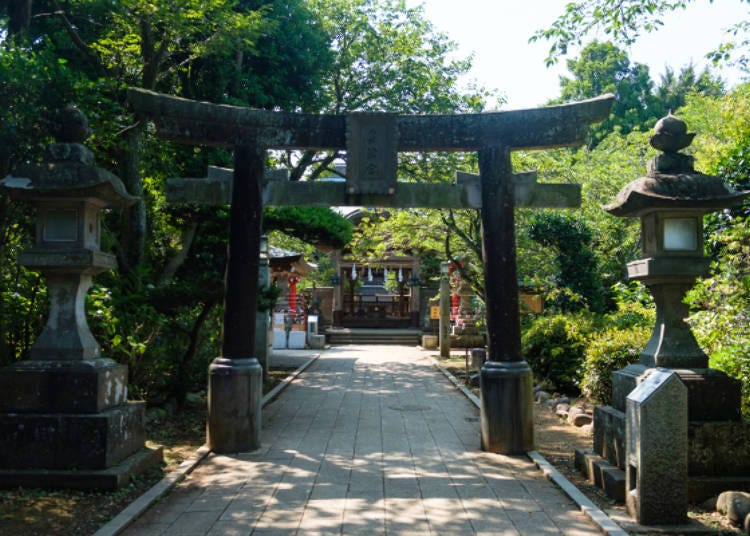
After about 15 minutes, we arrived at the third part of Enoshima Shrine called Okutsunomiya. The eldest of the three sister deities is enshrined here.
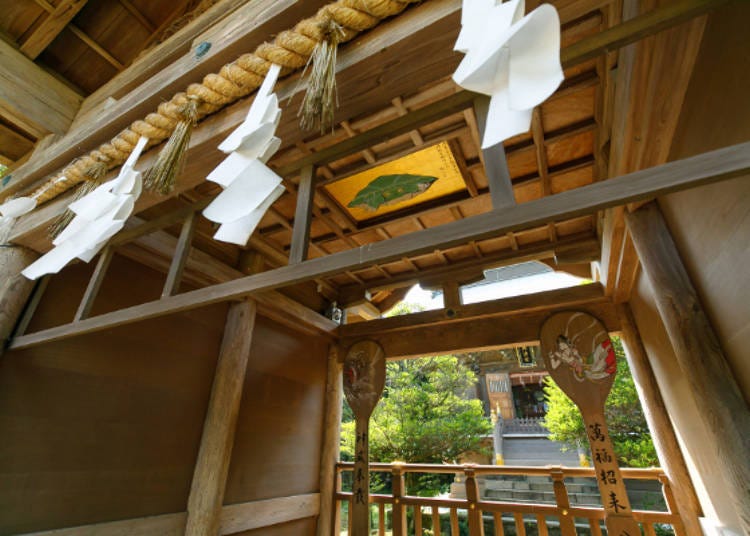
The ceiling of Okutsunomiya’s worship hall features the happonirami no kame, the “all-seeing turtle,” so to speak. No matter where you go, the turtle’s eyes seem to follow you, which is where the name comes from. If you have a hard time believing that, try it for yourself—walk around for a bit and keep looking at the turtle. It’ll stare right back.
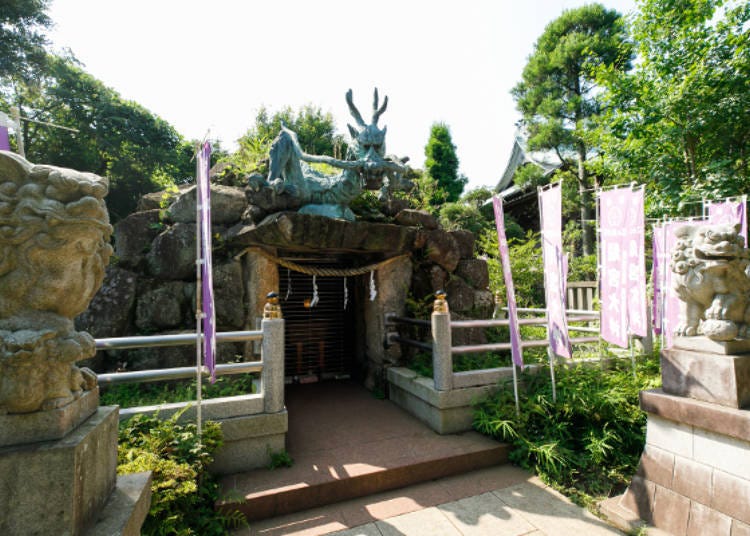
Walk a little further and you’ll stand in front of Wadatsunomiya, built in 1994 to recreate the dragon legend. A dragon sits at the top of the shrine, clearly protecting the area. It is rumored that this shrine sits right above the Iwaya Cave.
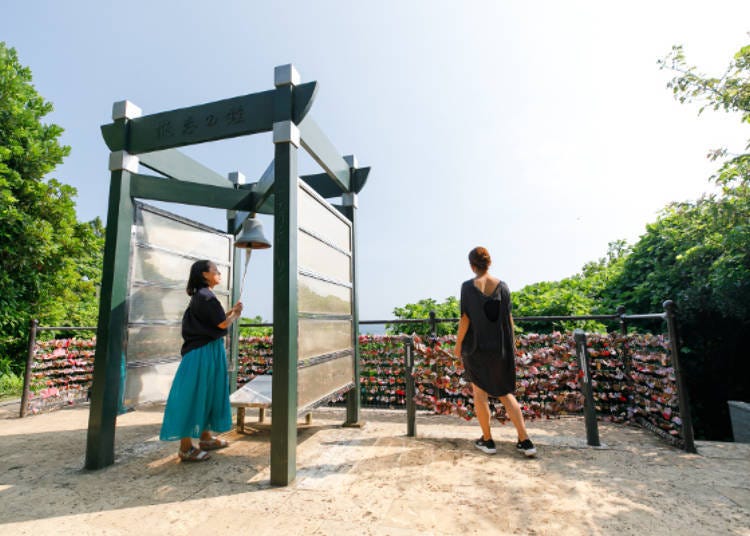
We move on from Okutsunomiya and go up the stairs on the left side, arriving at the Ryuren Bell of Love. As the name suggests, it is part of the story of the five-headed dragon that fell in love with the goddess, and, of course, it’s a popular spot for couples. Legend has it that ringing the bell acts as a profession of love for one another, and watching the ocean while ringing the bell is sure to make for a romantic moment. It’s also custom to hang a padlock near the bell, so why not get one at the nearby souvenir shops?
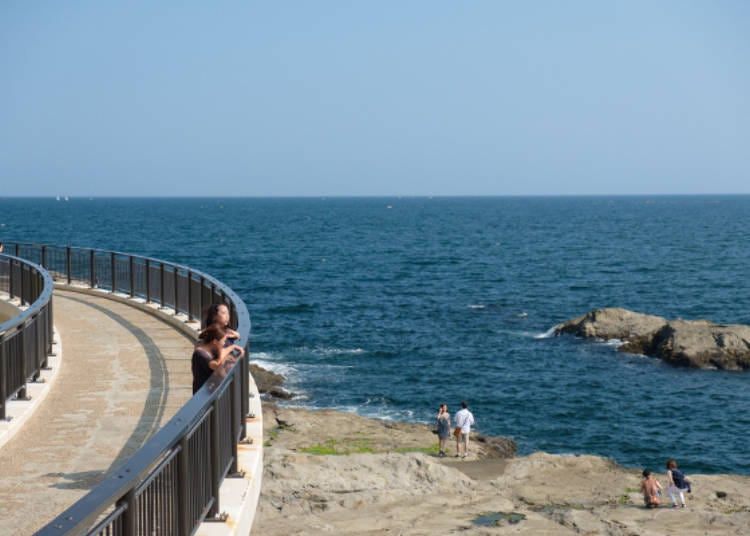
Having rung the bell, we go back to Okutsunomiya and head down the stairs towards Chigogafuchi. You can see the ocean on the right. The waves were calm, so a lot of people walked down to the flat rocks of Chigogafuchi, taking pictures and enjoying the sea.
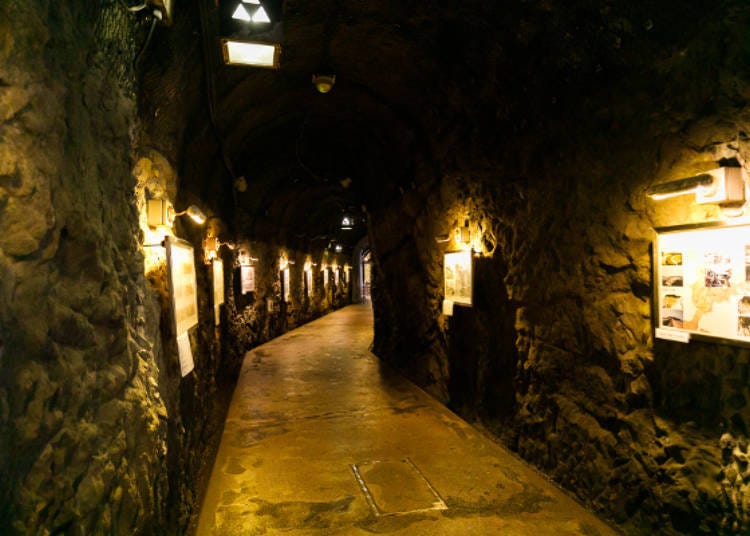
From the beautiful scenery of Chigogafuchi, we moved on to the Enoshima Iwaya Cave. Created by continuous erosion, the cave is split into two parts. At the entrance, we paid the admission fee (500 yen for adults, 200 yen for junior high and elementary school students) and headed down the stairs, immediately greeted by the first gallery. The cave is fairly cool and you might feel a chill even in summer, so we recommend bringing a light jacket.
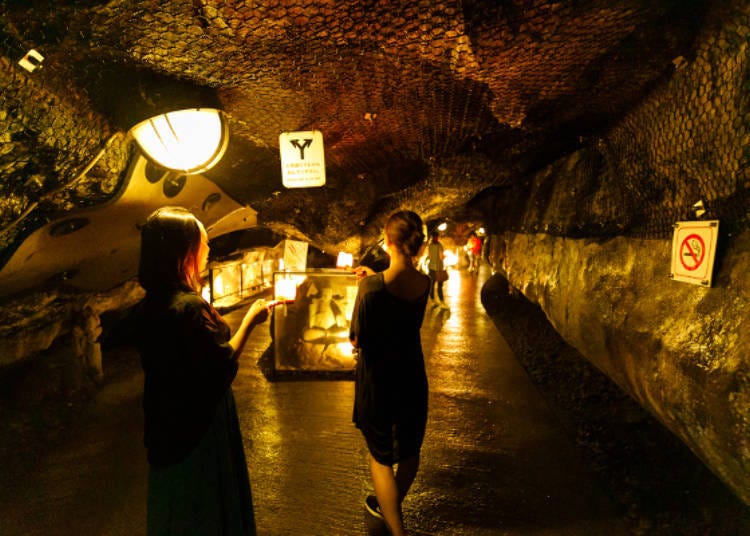
Turn left at the end of the gallery and you’ll stand inside Iwaya Cave #1 with a depth of 152 meters. With a small candle that you get at the entrance, it feels like you’re venturing into unexplored territory! Children get small candles with artificial fire, making the adventure fun and safe.
The mysterious atmosphere of the cave sent a pleasant chill down our spines and at the very back, we encountered a fork in the cave path. One of them said “To Mount Fuji” and even though it seemed to be a dead end, you can feel a breeze coming from that direction, making you wonder whether there really might be a passage to the famous mountain. The other path leads to the original site of Enoshima Shrine, said to have been built in 552.
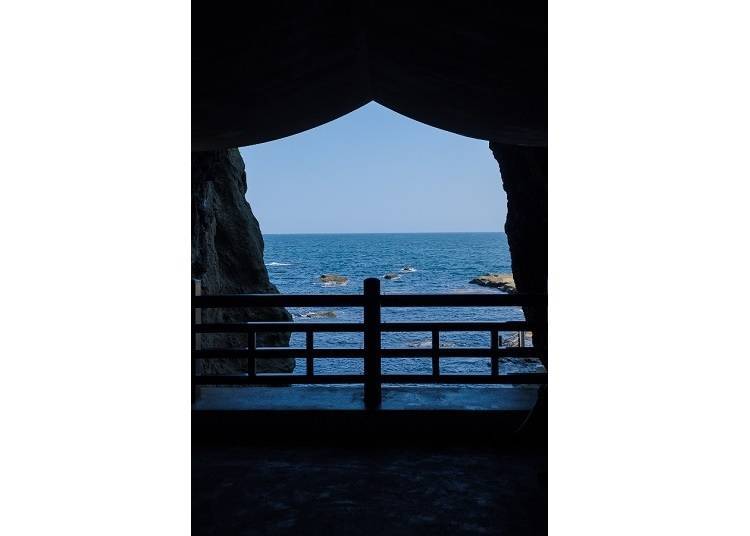
Next up is Iwaya Cave #2 and on the way to it, you’ll encounter a hole in the cave. You can see the see from there, almost resembling a theatrical stage. Some people used the opportunity to take a short break at the nearby benches, gazing at the enigmatic view.
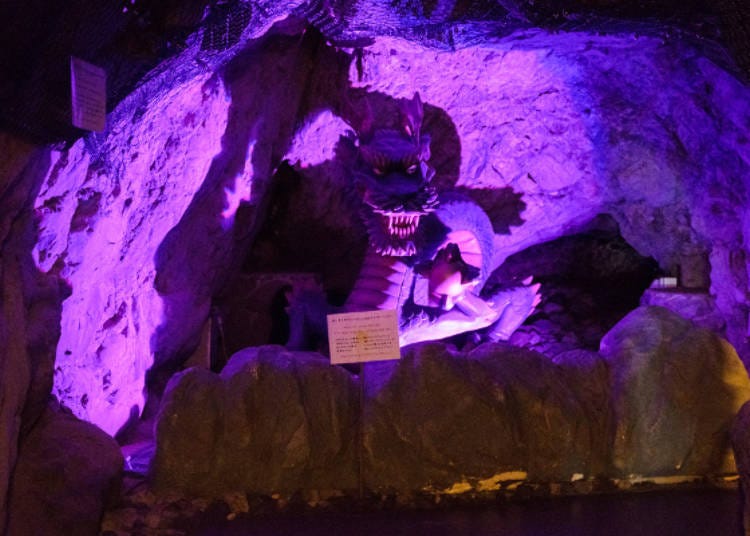
Enoshima has long harbored a strong dragon faith and the Iwaya Cave plays a central role in it. Of course, another dragon waits patiently in the dark of Iwaya Cave #2. Rumor has it that whatever wish you make will come true if the light that illuminates the dragon changes color right at the second when you clap in your hands twice, the traditional way of worship.
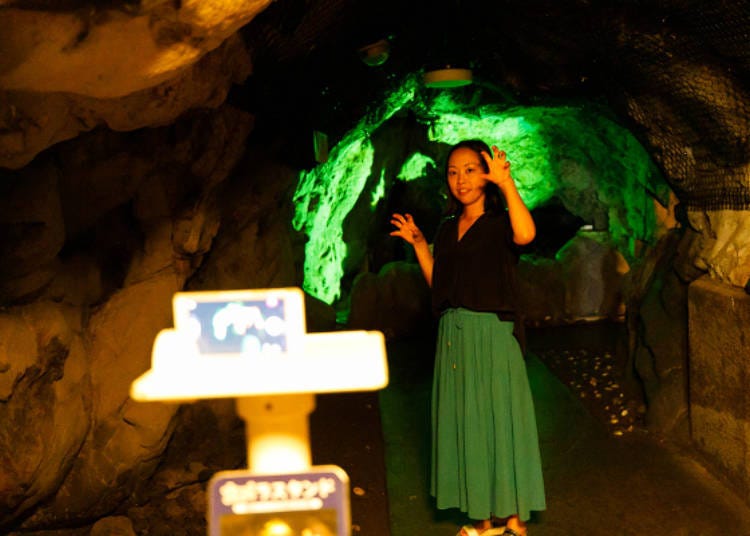
Nine photo stands are installed around Enoshima Island, making it extra convenient to get a perfect group shot or selfie. One of them is right in front of the dragon in the cave!
-

-
Address
2, Enoshima, Fujisawa-shi, Kanagawa, 251-0036
View Map -
Nearest Station
Katase-Enoshima Station (Odakyu Enoshima Line)
30 minutes on foot
- Phone Number 0466-22-4141
-
Address
2, Enoshima, Fujisawa-shi, Kanagawa, 251-0036
Tako Senbei, Octopus Rice Crackers: Savor Enoshima’s Traditional Specialty!
Exploring the Iwaya Cave made us hungry, so we decided to try Enoshima’s specialty tako senbei, octopus rice crackers. For that, we headed to a shop called Asahi, going back up to Enoshima’s summit. It sits on the Benzaiten Nakamise-dori Street, enticing people with their flavorful crackers (400 yen).
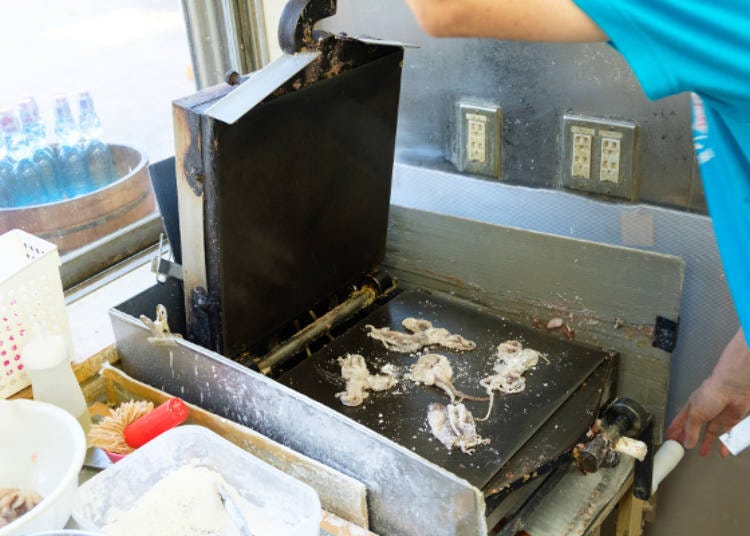
This specialty is made by pressing whole octopuses into a very thin shape on a 200-degree iron plate. A lot of things go into one such cracker—how many octopuses to use, the time it will take, how to arrange everything for a nice shape, and so on. Apparently, the taste only unfolds properly when the cracker is very thin. The skill of the chefs can be tasted with every bite of this flavorful treat!
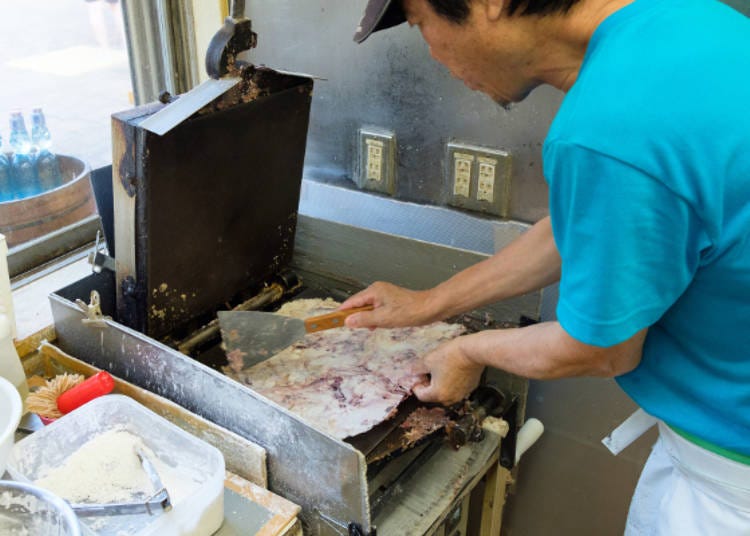
A large could of steam rise sup from the iron plate as the octopuses are pressed, tickling your nose with a rich, enticing aroma! The octopus rice crackers are freshly made with every order, a process that takes about two minutes. They’re so thin and delicate, you need to be careful when you hold it as not to accidentally break it.
A pleasant crunch fills your ears with every bite while the rich octopus flavor spreads over your tongue. Moderately salty, it goes great with a cold beer. A lot of people buy these rice crackers as a souvenir (2 for 800 yen).

Because the wind is rather strong at Enoshima’s summit, the whole cracker is broken into two pieces so that it doesn’t break. At Asahi’s head store, you’ll get one giant cracker as a whole.
-
Asahi Main Store丸焼きたこせんべいのあさひ本店
- Address 1-4-10 Enoshima, Fujisawa-shi, Kanagawa-ken 251-0036
- Phone Number 0466-23-1775
Hours: 9:00 a.m. – 6:00 p.m.
Closed: Thursdays
Summit Store:
Hours: 9:00 a.m. – 5:30 p.m.
Closed: always open
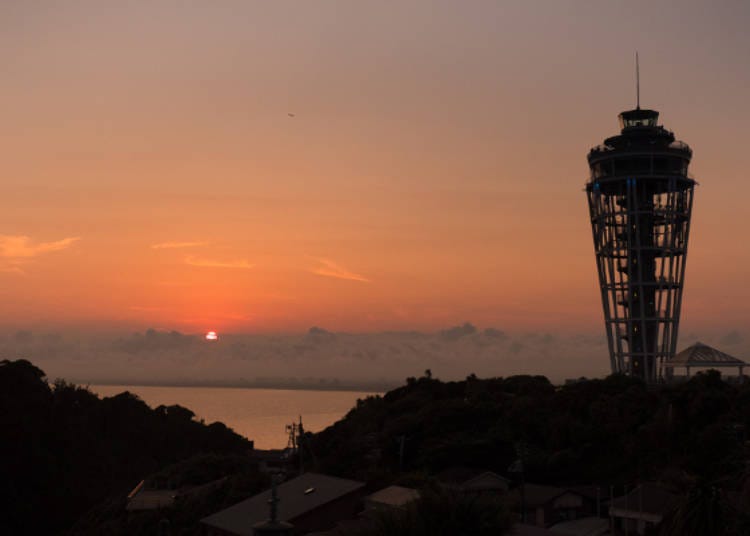
We wanted to conclude our day on Enoshima by watching the sunset. The island is dotted with beautiful sunset spots, such as Chigogafuchi or Sea Candle’s Sunset Terrace.
We decided to see the sunset from the observation deck at Kamegaoka Plaza. It’s a popular spot because the scenery features Sea Candle, the sea, and the sunset in one stunning picture. We arrived a little earlier to rest our legs and watch the sky change from blue to orange.
We arrived about 15 minutes before sunset and there were already a lot of people preparing for the natural spectacle. It’s wonderful to just sit there and watch the sky change color, taking pictures and taking in the enigmatic atmosphere of this magical moment.
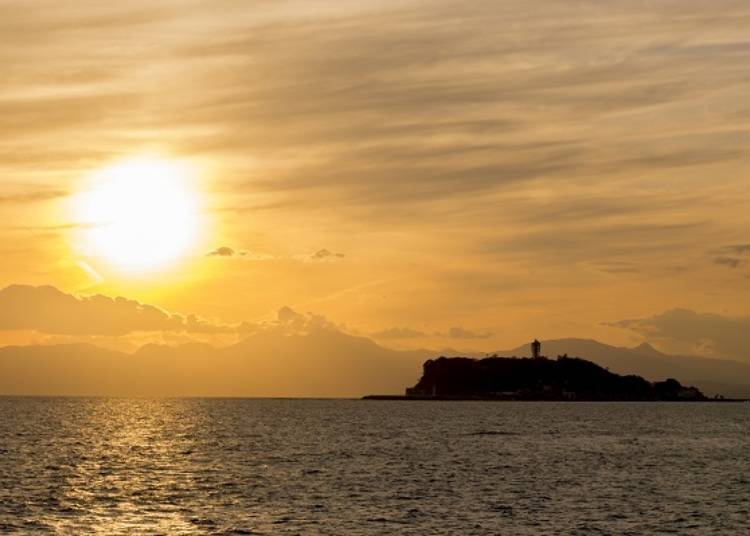
We toured a lot of Enoshima’s major sights today, but if you want to focus your sightseeing on worshiping at Enoshima Shrine, we recommend taking the pleasure boat “Bentenmaru” that connects Chigogafuchi and Enoshimabenten Bridge. The Shonan area scenery is absolutely breathtaking from the boat.
(One-way: 400 yen for junior high and older, 200 yen for 6 years to elementary school, free for 5 years and younger. Irregular operation. For inquiries: 0466-24-4141, Katase Enoshima Tourist Information)
-

-
Address
2-3-8, Enoshima, Fujisawa-shi, Kanagawa, 251-0036
View Map -
Nearest Station
Katase-Enoshima Station (Odakyu Enoshima Line)
15 minutes on foot
- Phone Number 0466-22-4020
-
Address
2-3-8, Enoshima, Fujisawa-shi, Kanagawa, 251-0036
After enjoying the sunset, we headed down the stairs and slope, walking towards the station. Crossing Enoshimabenten Bridge in the dark was quite a feat, but turning around to the nightly scenery of Enoshima was a sight we’ll never forget.
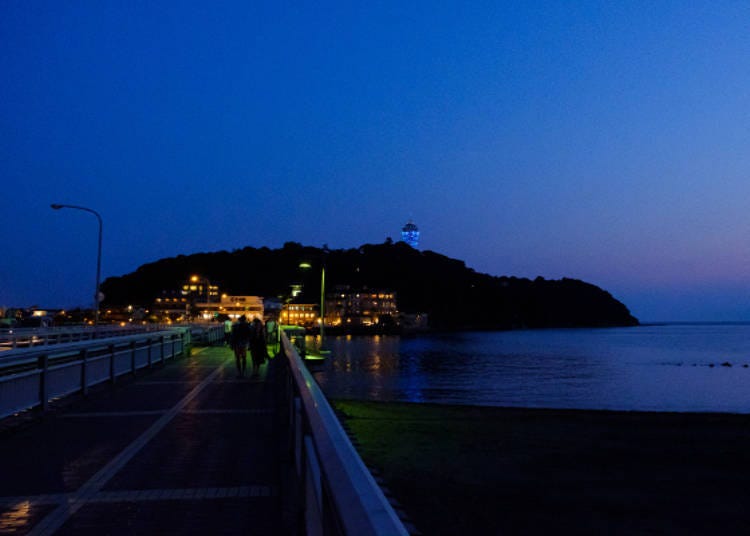
While we were rather tired from walking all day, our day on Enoshima was genuinely amazing. Filled with lush nature, beautiful sights, and plenty of discoveries, the legend of the dragon who fell in love with a goddess—this blend is what makes Enoshima incredibly unique and fascinating.
If you stay in Tokyo and want to venture out to see some other corners of Japan without having to pay for a hotel, do go to Enoshima. It’s going to become one of your favorite travel memories for sure.
- Area
- Category
*Prices and options mentioned are subject to change.
*Unless stated otherwise, all prices include tax.
Recommended places for you
-

BicCamera Coupon! Tax-free, Plus Discount!
-

Top Tips for Tourists! Roppongi Project for Safety and Peace of Mind: Creating a Fun and Safe Roppongi for All
-

5 Quirky Japanese Summer Festivals You Must See: Dancing, Fire, Bellybuttons & More!
-

Experience the Magic: Mt. Fuji and Lake Kawaguchi Fireworks Festival (August)
-

Shinjuku Shopping Guide: 15 Must-Visit Stores for Exclusive Deals in Tokyo
-

Farewell, Doctor Yellow! Japan’s Legendary Shinkansen Bullet Train's Retirement Announced - Starting 2025
Inspiration for Accommodations
-

10 Asakusa Hotels Featuring Views of Tokyo Skytree®
-

8 Scenic Hakone Lodgings with Breathtaking Views of Mount Fuji from Your Room
-

Make Your Tokyo Stay Comfortable! 10 Convenient Hotels with Airport Shuttle Service
-
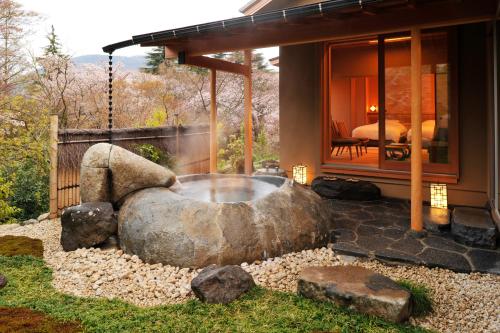
10 Open-air bath Onsen Ryokans in Hakone for Ultimate Relaxation
-

10 Family-Friendly Hotels with Comfortable Family Rooms in Asakusa
-

Asakusa's Comfortable Long Stay Hotels: 10 Picks with Complete Kitchens
-

Experience Luxury: Hakone's 10 Best Five-Star Accommodations
-
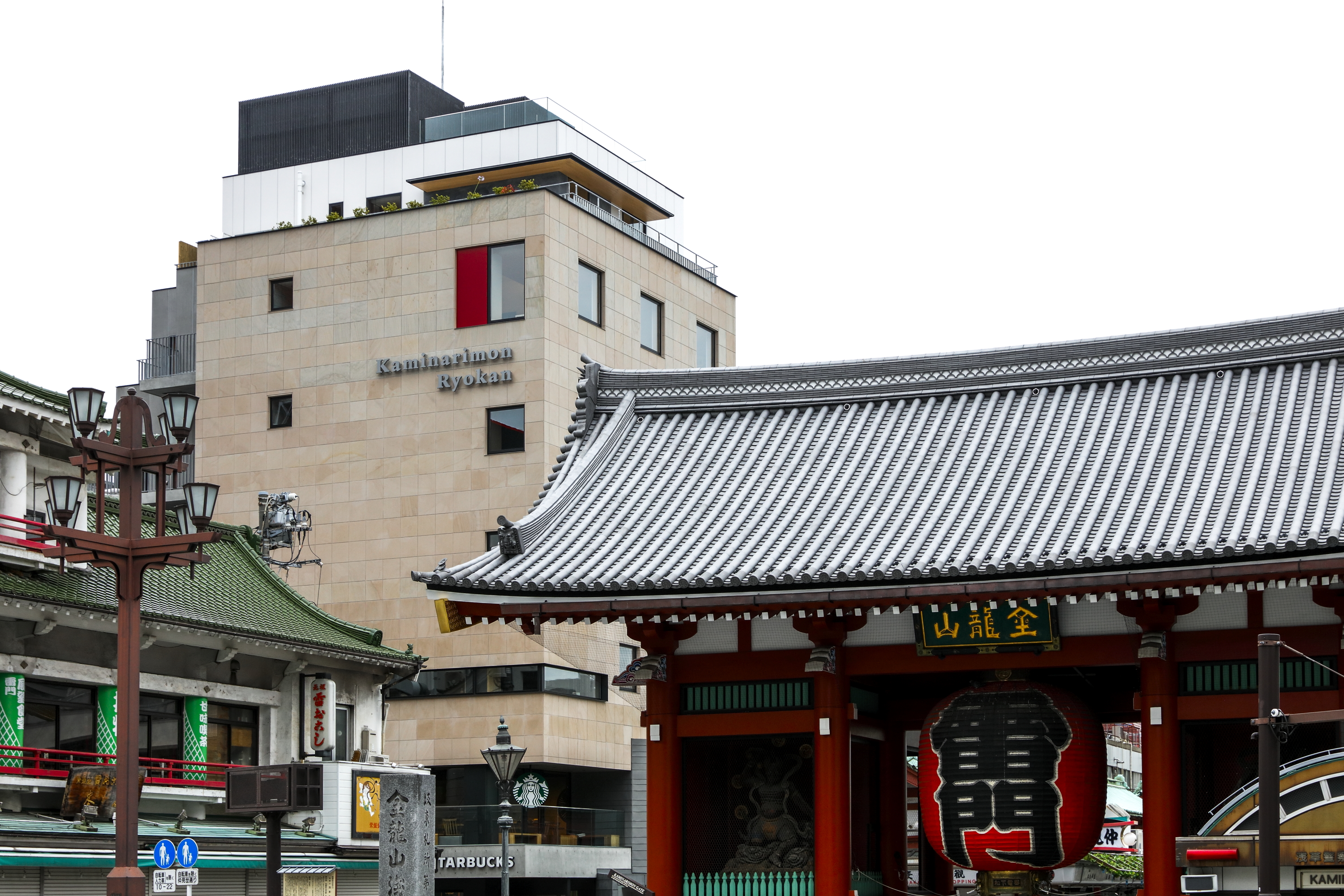
Best Picks for Hotels Near Asakusa Station – Top 10 List
-

10 Best Hotels in Tokyo with Gyms for a Comfortable Workout Experience
-

Enjoy a Comfortable Stay!10 Concierge Service Hotels in Hakone
-

Atami 1-Day Itinerary: Exploring Japan's Castle & Hot Springs Resort Town Near Tokyo!
-

Tokyo Tsukiji|Tsukiji Area Map & Sightseeing Information
-

Exploring Tokyo Station: 10 Must-Visit Spots Around the Heart of Tokyo
-

Tokyo Roppongi: 5 Most Amazing Spots at Roppongi Hills and How to Make the Best of Them!
-

Day Hiking Near Tokyo: 6 Easy Hikes You Can Do While Visiting Japan
-

Kichijoji – Explore Tokyo’s Top-Rated Stylish Suburb in Half a Day!
- #best ramen tokyo
- #what to buy in ameyoko
- #what to bring to japan
- #new years in tokyo
- #best izakaya shinjuku
- #things to do tokyo
- #japanese nail trends
- #what to do in odaiba
- #onsen tattoo friendly tokyo
- #daiso
- #best sushi ginza
- #japanese convenience store snacks
- #best yakiniku shibuya
- #japanese fashion culture
- #best japanese soft drinks






















